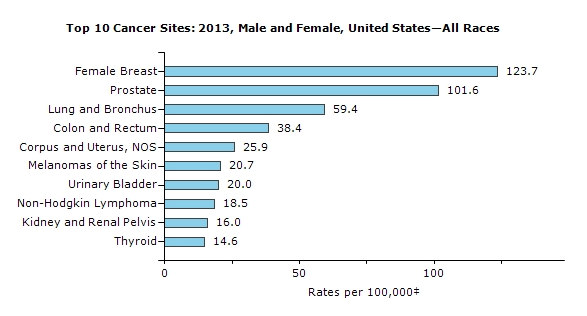The most deadly form of skin cancer kills an estimated 10,000 Americans per year, with the death toll rising each year. Yet there is no consensus in the medical community on a uniform, data-based protocol to screen for the disease.
But now, a team of professionals who study and treat melanoma are looking to change that.
The association, the Future Science Group, said that, "more than 50 leading members of the skin cancer field brought their expertise together to review current screening practice in primary care," according to a statement released today announcing its new paper.
These experts are concerned that even though melanoma is one of the most deadly forms of all cancers – not just skin cancers – "the safest and most cost-effective method of screening for melanoma ... is through total body skin examination," and it does not currently include other objective, measurable standards.
That means discovering the presence of melanoma only occurs after it appears to the naked eye, which the group finds problematic.
"It’s surprising that our field is currently without a national consensus for skin cancer screening guidelines for patients without symptoms,” said Dr. Sancy Leachman, the Director of the Department of Dermatology, Melanoma Research Program at Oregon Health & Science University, in Portland. She and her colleagues are looking to have analytic methods established that are on par with other screening practices established by the U.S. Preventative Services Task Force.
 “One of the goals of this paper was to propose data-driven, evidence-based guidelines for screenings that are consistent with the USPSTF guidelines for other cancers and diseases," added Dr. Leachman, who earned her M.D. and Ph.D from the University of Texas Southwestern Medical School. "The guidelines are of course just a starting point based on patient data we’ve reviewed to date, but we’ve identified a strong need to provide providers with initial recommendations outlining when to recommend screenings to their patients.”
“One of the goals of this paper was to propose data-driven, evidence-based guidelines for screenings that are consistent with the USPSTF guidelines for other cancers and diseases," added Dr. Leachman, who earned her M.D. and Ph.D from the University of Texas Southwestern Medical School. "The guidelines are of course just a starting point based on patient data we’ve reviewed to date, but we’ve identified a strong need to provide providers with initial recommendations outlining when to recommend screenings to their patients.”
The FSG, founded in 2001, bills itself as "a progressive publisher focused on breakthrough medical, biotechnological and scientific research."
The most recent report on skin cancer screening released by the USPSTF – a reputable, independent organization not affiliated with the federal government – states that "the current evidence is insufficient to assess the balance of benefits and harms of visual skin examination by a clinician to screen for skin cancer in adults."
In 2016, there were roughly 76,400 cases of melanoma (an example of which is above, courtesy: Shutterstock) and 10,100 Americans died from the disease, according to the USPSTF in its July 2016 report.
Those figures are significantly higher than those from 2013 published by the Centers for Disease Control and Prevention, which stated that "71,943 people in the United States were diagnosed with melanomas of the skin, including 42,430 men and 29,513 women," and that "9,394 people in the United States died from melanomas of the skin, including 6,239 men and 3,155 women."
 The 2013 figures, updated last June, are the most recent year numbers available from the CDC, which also reports that "Melanomas of the Skin" are the sixth most common type of fatal cancer in the U.S. (More recent statistics in this area are unavailable, states the CDC, because "delays in reporting melanoma cases to cancer registries are more common since they are usually diagnosed and treated in non-hospital settings such as physician offices."
The 2013 figures, updated last June, are the most recent year numbers available from the CDC, which also reports that "Melanomas of the Skin" are the sixth most common type of fatal cancer in the U.S. (More recent statistics in this area are unavailable, states the CDC, because "delays in reporting melanoma cases to cancer registries are more common since they are usually diagnosed and treated in non-hospital settings such as physician offices."
In addition to melanoma, the other two most common forms of skin cancer are basal and squamous cell carcinoma. Known together as non-melanoma skin cancer, they "represent the vast majority of all cases of skin cancer (>98%). However, nonmelanoma skin cancer rarely results in death or substantial morbidity (<0.1% of patient deaths are caused by this type of cancer)," states the USPSTF.
The FSG's new paper, just published in the journal Melanoma Management, included proposed screening guidelines such as:
- "A target age range of 35–75 years ... established based on several trends observed among the various USPSTF-derived age ranges for malignancies"
- Utilizing methodology from "Australia, New Zealand, Germany, the Netherlands and the UK [which] recommend screening certain subsets of patients at increased risk for melanoma"
- Focusing more on "Target risk groups .... established by comparing the relative risks/odds ratios of melanoma risk factors with the relative risks/odds ratios associated with risk factors for developing other common diseases and malignancies"
Focusing on high-risk groups seems to make sense. For example, the CDC reports that in the United States, "More than 9 out of 10 cases of melanoma are diagnosed in non-Hispanic whites."




